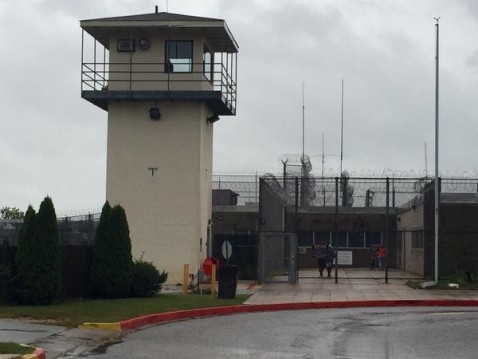The coronavirus pandemic caused a historic drop in Maryland’s prison population. But after the state of emergency ended and prisons filled up again, the share of Black incarcerated people reached a five-year-high late last year, a Capital News Service data analysis has found.
In March 2020, around 18,500 people were incarcerated in the state’s prisons. By summer 2021, there were almost 4,000 fewer prisoners. Never before had the state prison population decreased so dramatically in just one year.
Since then, the prison population has swelled again to more than 16,000 people as of last October — still significantly lower than pre-pandemic levels.
Black inmates accounted for 72.4% of state prisoners in the last quarter of the fiscal year 2023, although Black people make up less than a third of Maryland's population overall.
The share of incarcerated Black people is up from 70% in the first quarter of fiscal 2018 and higher than the 72% at the beginning of the pandemic, data by the Department of Public Safety and Correctional Services reveals.
"One percentage point in this context is quite substantial," Brennan Klein, associate research scientist at Northeastern University, told CNS. Since prisons incarcerate large populations, even small changes can be significant, he added.
Klein was the lead author of an earlier study published in the science journal Nature that found sharp increases in the share of Black and Latino prisoners at the beginning of the pandemic across the nation. Maryland was among only five states that did not follow the national trend.
In fact, the share of Black prisoners declined while Maryland was under the coronavirus state of emergency. Only after it ended, the percentage of Black people incarcerated in state prisons climbed.
In October, Maryland Attorney General Anthony Brown and Public Defender Natasha Dartigue announced a new partnership to reduce mass incarceration of Black people in the state.
"It is a sad reality that the vast majority of people who have been removed from communities across the country and put behind bars are Black," Brown said in a press release.
The Maryland Equitable Justice Collaborative, which brings together government, academic and criminal justice experts, will present plans for reforms early next year.
Four years ago, then-Gov. Larry Hogan issued an executive order to slow the spread of the coronavirus in prisons.
Those scheduled to leave within the next four months were eligible for early release. Incarcerated people over the age of 60 were considered for accelerated parole if they had a good record, a home plan and had not been convicted of a violent crime or sexual offense.
According to the DPSCS, 484 people were eligible to leave prison. Department spokesperson Latoya Gray said that Hogan's executive order made accelerated placements in home detention possible. According to her, placements stayed 30% higher a year after the first executive order.
A second Hogan executive order came in November 2020, again allowing early releases for a fraction of prisoners.
These early releases likely had a negligible effect on the total size of prison population.
The number of prison intakes, however, dropped sharply in the first pandemic year. Right before the coronavirus hit Maryland in March 2020, the intakes hovered around just under 450 per month. In April, only three people were incarcerated. All of them were Black men.
In the same month, 515 people left state prison. A lack of intakes while releases continued caused a significant reduction in the state's prison population.
Nationwide, lower crime rates and court closures halted incarceration early in the pandemic. This caused a historic drop in prison populations, but also exacerbated racial inequalities, according to Klein's study.
Klein traced back racial disparities to differences in sentence lengths. Black people are more likely to serve long sentences and White people tend to be incarcerated for shorter periods.
"On any given day, if someone's being released, they're more likely to be White," Klein said.
Maryland data shows that Black prisoners are much more likely to serve sentences longer than 25 years. According to Klein, the pandemic effect was weakened because the state hands out fewer short sentences overall, slowing down turnover that mostly benefited White prisoners in other parts of the nation.
Still, racial disparity in Maryland prisons is more than double the national average, according to a 2019 report by the Justice Policy Institute, a think tank that aims to reduce mass incarceration.
The Justice Policy Institute found that incarcerated people disproportionately come from poor communities such as Southwest Baltimore. A 2022 report established a connection between incarceration and neighborhoods with high unemployment, low income and fewer people with a high school diploma.
"Instead of investing in those communities, the state has invested into the justice system," said Keith Wallington, director of advocacy at the Justice Policy Institute.
Experiencing the spread of the coronavirus behind bars was scary, people incarcerated in Maryland told researchers.
Poor ventilation and close quarters can contribute to the spread of infectious diseases such as COVID-19, Lauren Porter, associate professor of criminology and criminal justice at the University of Maryland, told CNS.
According to the Covid Prison Project, Maryland prisons had a lower COVID-19 death rate than the general population. Again, the state was an outlier.
Those leaving prison at the height of measures against the pandemic faced challenges as well.
"There's an incredibly high risk of death immediately following release, especially from things like overdose," Porter said.
"The liquor store was open during COVID, but not the reentry programs," said Janette Graham, founder of the reentry service organization No Struggle No Success. During the stay-at-home orders, newly released people couldn't immediately access in-person services, such as substance abuse therapy, she said.
Jacob Kang-Brown, research fellow at the criminal justice nonprofit Vera Institute of Justice, said that the tight labor market might have actually helped those trying to re-enter society after serving time in prison.
He predicted that states will continue to explore large releases of people from prison "as a way to correct years and years of heavy sentences."

